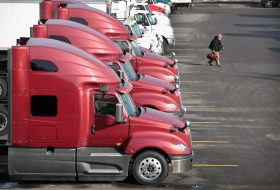Commercial hauling trailers are seen every day on the highways and roadways. Commercial truck drivers utilize these trailers to haul the products that we see on store shelves, in the office and around the home. Commercial hauling trailers come in many shapes and sizes, and all of them serve a specific purpose.
Dry Box
•Dry box trailers are the type most often seen on the highways. Dry goods such as electronics, clothing, groceries and other dry products are hauled in these trailers. The standard lengths are 28, 32, 34, 46, 40, 45, 48 and 53 feet.
Tanker
•A tanker trailer is generally a cylindrical trailer used for transporting liquids such as milk, asphalt, liquid chemicals, gasoline and dry chemicals in large quantities. Department of Transportation placards are required on tanker trailers to identify the liquid on board.
Flatbed
•The flatbed trailer has a load floor with removable side rails and a bulkhead that protects the tractor in case of a shift in the load. Flatbeds can be used to haul anything that can be stacked and strapped down. They are either 48 or 53 feet in length. Some flatbeds have side kits that can be used to secure the load or for hauling goods such as produce.
Curtain Side
•The curtain side trailer is similar to the dry box trailer with the exception that the sides have movable curtains. The curtains are a reinforced fabric with a waterproof coating. It has the security of a dry box trailer, the ease of loading of a flatbed and it is weather resistant. A common use for this trailer is hauling lumber in wet climates.
Lowboy
•The lowboy is a type of flatbed on which the load floor is as low to the ground as possible. The trailer is designed to drop to the ground, allowing for easy loading. These are used for hauling heavy equipment such as bulldozers and cranes.
Double Decker
•Double decker trailers have a movable second floor so that more palletized goods can be carried. Generally a double decker can haul 40 pallets, compared with 26 pallets on a standard trailer. Double deckers generally have a stepped van or a curtain side. The second deck can be either fixed or a hinged variety that swings into position along the length of the trailer. This can be divided into two or three sections, which allows greater load flexibility.
Extendable
•The extendable trailer is a flatbed that has a beam going along the middle of the trailer so the load surface can extend. This allows for longer loads, such as aircraft parts or timber. A special permit is normally required, as well as a lead and follow car.
Car Carrying
•A car carrier is a trailer that can carry multiple cars at once and has ramps for easy loading and unloading. These trailers are also a double decker. Hydraulics allow the upper level to lower for easier loading. Car carrying trailers can also have curtain sides, which are normally used for hauling high-end vehicles.
Reefer (Refrigerated)
•The reefer, or refrigerated, trailer is a box with a cooling/heating unit attached. The reefer trailer looks like a dry box trailer with the exception of a cooling unit mounted on the front. The sides and doors are insulated. This is used for hauling perishable items such as ice cream, dairy and produce.
Side Lifter
•The side lifter is a flatbed commercial trailer that has hydraulic cranes mounted at either end of the chassis, allowing loading and unloading of containers without the need of a forklift. This trailer is also used for hauling large pipes and concrete barriers.


